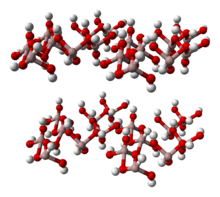
| |

| |
| Names | |
|---|---|
| Preferred IUPAC name
Aluminium hydroxide | |
| Systematic IUPAC name
Trihydroxidoaluminium | |
Other names
| |
| Identifiers | |
3D model (JSmol)
|
|
| ChEBI | |
| ChEMBL | |
| ChemSpider | |
| DrugBank | |
| ECHA InfoCard | 100.040.433 |
| KEGG | |
PubChem CID
|
|
| RTECS number |
|
| UNII | |
CompTox Dashboard (EPA)
|
|
| |
| Properties[1][2] | |
| Al(OH)3 | |
| Molar mass | 78.003 g·mol−1 |
| Appearance | White amorphous powder |
| Density | 2.42 g/cm3, solid |
| Melting point | 300 °C (572 °F; 573 K) |
| 0.0001 g/(100 mL) | |
Solubility product (Ksp)
|
3×10−34 |
| Solubility | soluble in acids and alkalis |
| Acidity (pKa) | >7 |
| Isoelectric point | 7.7 |
| Thermochemistry[3] | |
Std enthalpy of
formation (ΔfH⦵298) |
−1277 kJ·mol−1 |
| Pharmacology[4] | |
| A02AB01 (WHO) | |
| Hazards | |
| GHS labelling: | |
| no GHS pictograms | |
| no hazard statements | |
| P261, P264, P271, P280, P304+P340, P305+P351+P338, P312, P337+P313 | |
| NFPA 704 (fire diamond) | |
| Flash point | Non-flammable |
| Lethal dose or concentration (LD, LC): | |
LD50 (median dose)
|
>5000 mg/kg (rat, oral) |
| Safety data sheet (SDS) | External MSDS |
| Related compounds | |
Other anions
|
None |
Related compounds
|
|
Except where otherwise noted, data are given for materials in their standard state (at 25 °C [77 °F], 100 kPa).
| |
Aluminium hydroxide, Al(OH)3, is found in nature as the mineral gibbsite (also known as hydrargillite) and its three much rarer polymorphs: bayerite, doyleite, and nordstrandite. Aluminium hydroxide is amphoteric, i.e., it has both basic and acidic properties. Closely related are aluminium oxide hydroxide, AlO(OH), and aluminium oxide or alumina (Al2O3), the latter of which is also amphoteric. These compounds together are the major components of the aluminium ore bauxite. Aluminium hydroxide also forms a gelatinous precipitate in water.
- ^ For solubility product: "Solubility product constants". Archived from the original on 15 June 2012. Retrieved 17 May 2012.
- ^ For isoelectric point: Gayer, K. H.; Thompson, L. C.; Zajicek, O. T. (September 1958). "The solubility of aluminum hydroxide in acidic and basic media at 25 ?c". Canadian Journal of Chemistry. 36 (9): 1268–1271. doi:10.1139/v58-184. ISSN 0008-4042.
- ^ Zumdahl, Steven S. (2009). Chemical Principles (6th ed.). Houghton Mifflin Company. ISBN 978-0-618-94690-7.
- ^ Black, Ronald A.; Hill, D. Ashley (15 June 2003). "Over-the-Counter Medications in Pregnancy". American Family Physician. 67 (12): 2517–2524. ISSN 0002-838X. PMID 12825840. Retrieved 1 July 2017.
